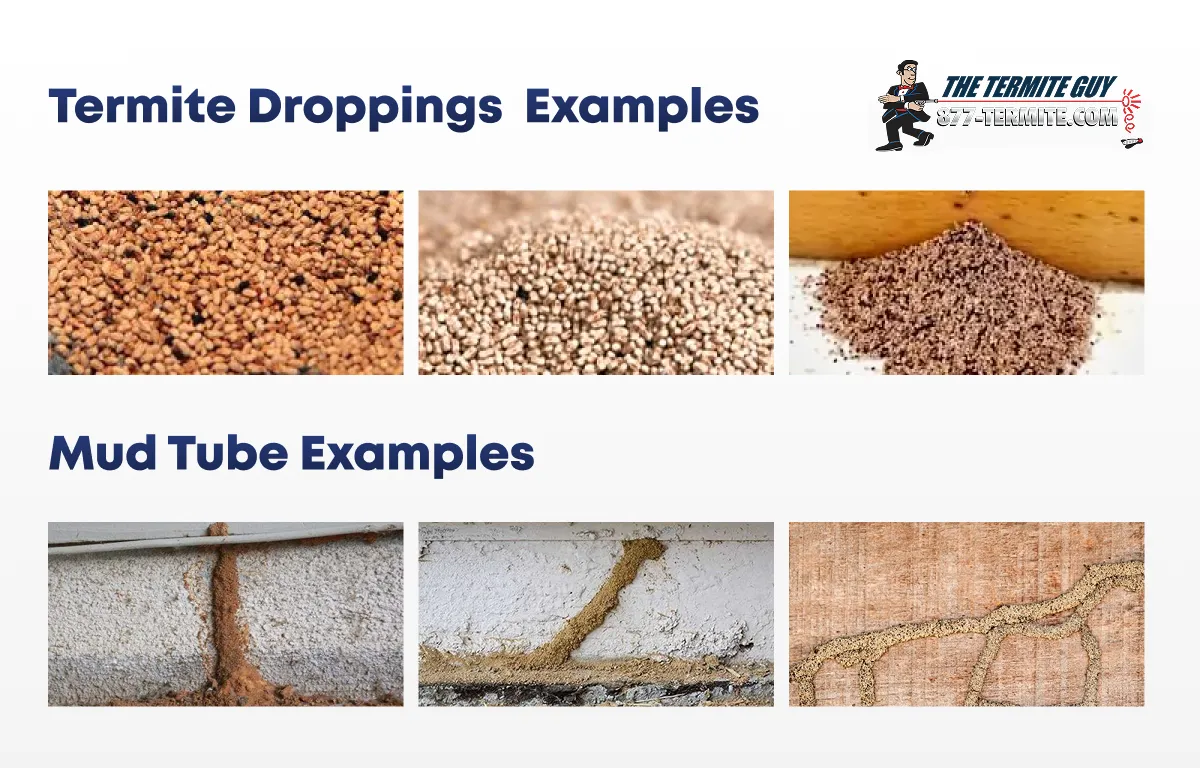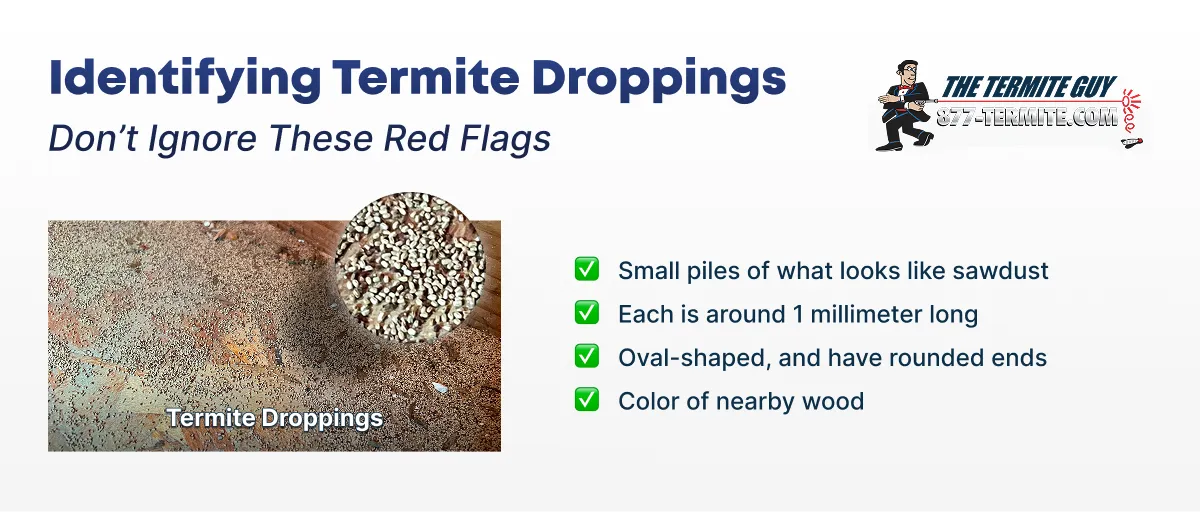Understanding Termite Droppings: What Every Homeowner Should Know
Termite droppings, also known as frass, are one of the most common signs of a termite infestation in homes and businesses throughout Orange County and Los Angeles County. Recognizing these tiny pellets can help you catch an infestation early, potentially saving you thousands in repair costs. But what exactly are termite droppings, and why should you care? This guide will walk you through everything you need to know, from identification to health risks and safe cleanup.
What Are Termite Droppings?
Termite Droppings Are a Byproduct of Wood Consumption
Termite droppings are the waste material left behind after termites consume wood and other cellulose-based materials. As termites tunnel through your walls, floors, or furniture, they digest the wood and expel the remnants as tiny, hard pellets. These droppings are a clear indicator that drywood termites, in particular, are active within your property.

Unlike subterranean termites, which use their waste to build mud tubes, drywood termites push their droppings out of small holes near their nests. This behavior results in visible piles of frass accumulating beneath infested wood, making it easier for homeowners to spot an issue. If you notice these signs, it’s a smart move to contact The Termite Guy for a professional inspection and peace of mind.
What Do Termite Droppings Look Like?

Termite Droppings Are Small, Pellet-Shaped, and Vary in Color
One of the most distinctive features of termite droppings is their appearance. These pellets are typically about 1 millimeter long, oval-shaped, and have rounded ends. The color can range from light beige to dark brown, depending on the type of wood the termites have been eating.
If you notice small piles of what looks like sawdust or coffee grounds near wooden structures, windowsills, or baseboards, you may be looking at termite frass. However, it’s important to distinguish these from other types of insect droppings or debris. If you’re unsure, The Termite Guy can help you identify the problem with a thorough inspection.
- Size: About 1 mm long (similar to ground pepper or poppy seeds).
- Shape: Six-sided, elongated, and slightly rounded at the ends.
- Texture: Hard and grainy — they don’t crumble when touched.
- Color: Can range from light tan to dark brown, often matching the color of the wood the termites are eating.
- Location: Usually found in small piles beneath “kick-out holes” in wood — the exit points termites use to push out waste.
How to Identify Termite Droppings in Your Home or Business
Look for Piles of Pellets Near Wooden Structures
Identifying termite droppings is crucial for early detection of an infestation. Homeowners and business owners in Southern California should regularly inspect areas where termites are likely to be active. These include attics, crawl spaces, window frames, and wooden furniture.
Termite frass is often found in small piles or mounds, especially below kick-out holes (tiny exit holes termites create in wood). These piles may accumulate on floors, windowsills, or even inside drawers and cabinets. If you spot these signs, it’s time to investigate further. For a professional assessment, reach out to The Termite Guy—our experienced team knows exactly what to look for and can confirm whether you’re dealing with termites.
- Location: Droppings are usually found directly below infested wood or near small holes in wood surfaces.
- Texture: Unlike sawdust, termite frass feels gritty and hard when pinched between your fingers.
- Pattern: Piles are often cone-shaped or scattered, depending on how long the infestation has been present.
Distinguishing Termite Droppings from Other Insect Waste
It’s easy to confuse termite droppings with other types of debris, such as sawdust from carpenter ants or general dust. However, termite frass is more uniform in size and shape, and lacks the fibrous texture of sawdust.
Are Termite Droppings Dangerous?
Termite Droppings Are Not Toxic, But Can Pose Health Risks
While termite droppings are not inherently toxic or poisonous, they can still present health concerns, especially for sensitive individuals. The primary risk comes from the potential for allergic reactions or respiratory irritation, particularly if the droppings become airborne during cleaning.
In most cases, simply touching or being near termite frass will not cause harm. However, the presence of droppings indicates an active termite infestation, which can lead to significant structural damage if left untreated. This makes prompt action essential for both your health and your property’s safety.
Can Termite Droppings Make You Sick?
Potential Health Effects of Exposure to Termite Frass
For most people, termite droppings do not pose a serious health threat. However, individuals with allergies, asthma, or compromised immune systems may experience symptoms if they inhale dust or particles from the droppings. These symptoms can include sneezing, coughing, or mild respiratory discomfort.
In rare cases, prolonged exposure to large amounts of termite frass could exacerbate existing respiratory conditions. It’s always best to err on the side of caution and avoid direct contact or inhalation, especially during cleanup.
- Allergic Reactions: Some people may develop mild skin or respiratory allergies when exposed to termite droppings.
- Asthma Triggers: Dust from frass can aggravate asthma symptoms in sensitive individuals.
- Secondary Risks: The real danger lies in the structural damage termites cause, which can lead to unsafe living conditions.
How to Get Rid of Termite Droppings

Safe Cleanup Practices for Homeowners
Cleaning up termite droppings is an important step, but it’s only a temporary solution if the underlying infestation is not addressed. Before you begin, make sure to wear gloves and a dust mask to minimize exposure to dust and allergens. Use a vacuum with a HEPA filter to carefully remove the pellets, and dispose of the vacuum bag or contents in a sealed plastic bag.
After vacuuming, wipe down the affected area with a damp cloth to remove any remaining particles. Avoid sweeping or using compressed air, as this can spread dust and allergens into the air. If the droppings are in hard-to-reach places, consider contacting a professional for safe removal.
- Wear Protective Gear: Gloves and a mask help prevent direct contact and inhalation of dust.
- Use a HEPA Vacuum: This type of vacuum traps fine particles and prevents them from becoming airborne.
- Seal and Dispose: Always seal droppings in a plastic bag before discarding to prevent contamination.
Why Professional Help Is Essential
While cleaning up droppings can improve the appearance and safety of your home, it does not eliminate the termite problem. Only professional termite control can address the root cause and prevent further damage. If you find termite frass, schedule an inspection as soon as possible to assess the extent of the infestation and develop a treatment plan. The Termite Guy specializes in thorough inspections and effective termite treatments for homes and businesses in Orange County and LA County.
Preventing Future Termite Infestations

Regular Inspections and Proactive Maintenance
The best way to prevent termite droppings from reappearing is to keep termites out of your property in the first place. Regular inspections by a licensed pest control professional can catch early signs of activity before they become a major problem. In Orange County and LA County, where drywood termites are common, annual inspections are highly recommended.
In addition to professional inspections, homeowners can take steps to reduce the risk of infestation. These include sealing cracks in wood, maintaining proper ventilation, and keeping firewood or debris away from the foundation of your home.
- Seal Entry Points: Caulk cracks and crevices in wood and around windows to block termite access.
- Reduce Moisture: Fix leaks and ensure proper drainage to make your home less attractive to termites.
- Store Wood Properly: Keep firewood and lumber at least 20 feet from your home and off the ground.
When to Call The Termite Guy
.webp)
Expert Termite Inspection and Treatment in Orange County & LA
If you’ve discovered termite droppings in your home or business, don’t wait for the problem to get worse. The Termite Guy offers thorough inspections, advanced treatment options, and ongoing protection plans tailored to the unique needs of Southern California properties. Our team uses the latest technology to detect and




